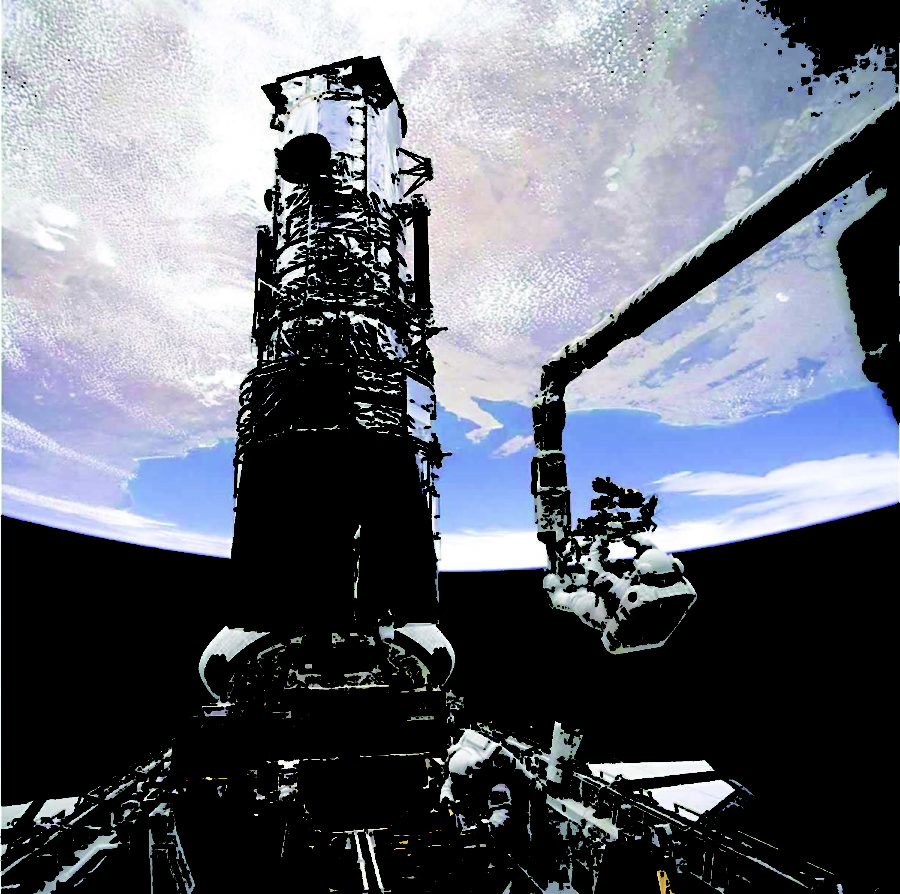Hanton: Science, education are worthy budget goals
Astronauts perform repairs and routine maintenance on the Hubble Space Telescope.
October 28, 2011
Years ago, astronomers dreamed up an amazing instrument that would be able to see 13 billion years into the past, just a short hop past the big bang (13.7 billion years back). It would orbit around the sun, held in place by both the sun and earth’s gravity at a point where it would be tugged along behind us while remaining a discreet 1.5 million kilometers away. This observatory would be the Hubble’s big brother with a 50 percent bigger mirror and a bunch of advanced features like a sun-shield and the ability to run its sensors at a frigid -388 degrees Fahrenheit.
They named this beast of a telescope the James Webb Space Telescope and after more than $3 billion dollars has already been spent on its construction, the United States House of Representatives is fighting to cancel the whole program. Yes, that’s right; they want to throw away $3 billion dollars of work because they are too worried about tightening belts in Washington to allow NASA to make any science-changing discoveries.
I wanted to write today a follow-up to my column last week on innovation, by writing about why “big science” like that done by the Hubble space telescope is important even when you don’t understand what the benefits are going to be today.
As I alluded to last week, “big science” projects — anything from the James Webb to the Superconducting Super Collider to the Manhattan Project — are vitally important to our country. We did not become the most technologically advanced nation in the world by accident or by mistake. Our grandfathers and great-grandfathers made some important decisions in their day to take on big bets to win the war in Europe and later to win the Cold War with the Soviet Union.
They pumped money into science and education as well as the military because they knew that it would be better to have a nimble, technologically advanced army, navy and air force than to maintain a large but primitive group of soldiers. They wrote brilliant men a blank check to develop the most cutting edge technology the world had ever seen.
While big technology and science programs had major applications in the wars of the day, they had a much bigger impact that was never planned. They sparked revolutions in the materials, technology and data fields as their brilliant designers searched for good solutions to tricky problems. In one instance, you can consider what might have happened if NASA had not needed thousands of brand new, hardly tested integrated circuits to be made for its spacecraft computers. Without NASA’s effort to prove and use a cutting edge technology like this, the computer revolution might have taken years longer to come to fruition.
Now, of course all of this innovation of the ’50s and ’60s didn’t come cheap. At the time, corporate taxes were more than 50 percent and personal taxes were well above 80 percent. But it could be argued that we are still reaping the benefits of the education and technology that was the focus of that time. Today, when our tax structure only collects half as much of our money in taxes, it only makes sense that we can do only half as much education and science work. (Unfortunately the military never quite got that memo — their cost-cutting in the 1990s was interrupted by Sept. 11, 2001.)
But I don’t understand why when we spend more than $700 billion per year on defense and still manage to lose shipments of billions in cash in Middle-East war zones, we can’t spend a measly $5 billion in the next seven years to build the most powerful space telescope ever. This is a program that is paying for highly skilled jobs all around the country and could allow us to take a look at planets orbiting distant stars. Yes, it doesn’t produce massive numbers of low-paying jobs, and I’m sure NASA’s lobbyists/administrators aren’t as good as those employed by large corporations, but NASA isn’t just throwing money down a hole here. They are investing in the future and in yet-unknown discoveries.
Yes, NASA made some mistakes. As noted by Dr. Pamela Gay at a recent event, one of NASA’s biggest faults with James Webb was to allow astronomers to put together a budget on their own. As she noted, astronomers are very good at studying stars and not so good at budgeting. Some of the ballooning cost of NASA’s new space telescope was added recently when they realized that nobody had added an operations budget to the overall cost of the James Webb (oops!).
In the end, we all make mistakes and NASA is working to correct theirs. But will it be enough?
Right now, the Senate and House are working to resolve their different perspectives on the program. The Senate voted to fully fund the JWST in 2012 and the House voted to defund it. So while they work to reconcile the bills, I urge you to talk to your representatives and make sure they don’t cut James Webb. Even a partial funding of the program for a year would cause a multi-year setback for astronomers worldwide. It’s really a question of whether we want to make the brilliant discoveries of tomorrow in the sky above us or bury our heads in the sand. You choose.

















